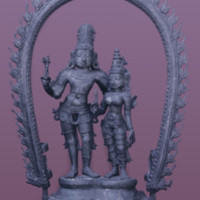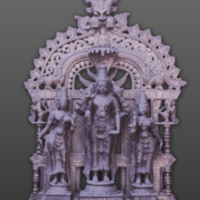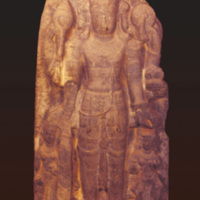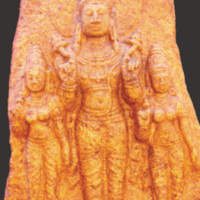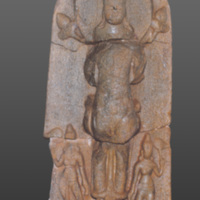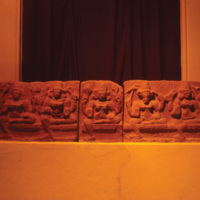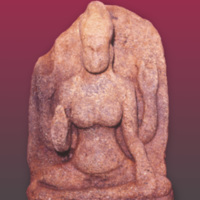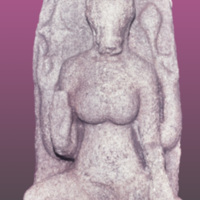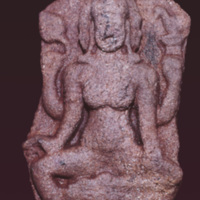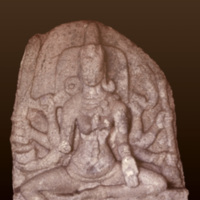Main Menu
AORC Libraries
Browse Archive Items (166 total)
Parvati, consort of Siva
Description: It is more usual for a single consort, Parvati, to be associated with Siva images as seen in this bronze representation found in the Colombo National Museum. Originally from one of the Siva devales at Polonnaruva, Sri Lanka, it is perhaps a work of the Polonnaruva period.
Contributor: Co-Author: Seneviratna, Harsha
Collection: Women in Sri Lankan Sculpture and Painting
Tags: AISLS, Goddesses in Hindu Worship, ICES, PDWESLSP
Goddesses, consorts of Vishnu
Description: Datable to about the 12th century A.D. on stylistic grounds, this bronze representation of Vishnu and his consorts, from the Colombo National Museum is framed by a tiruvasi or an arch of flames.
Contributor: Co-Author: Seneviratna, Harsha
Collection: Women in Sri Lankan Sculpture and Painting
Tags: AISLS, Goddesses in Hindu Worship, ICES, PDWESLSP
Two goddesses, consorts of Vishnu
Description: This 11th century stone relief of Vishnu with his two female companions, kept in the Colombo National Museum. Its original find spot was a Devalaya (Hindu shrines) in Polonnaruva, Sri Lanka.
Contributor: Co-Author: Seneviratna, Harsha
Collection: Women in Sri Lankan Sculpture and Painting
Tags: AISLS, Goddesses in Hindu Worship, ICES, PDWESLSP
Two goddesses, consorts of Surya.
Description: This stone relief of Surya, flanked by two female companions and datable in the Polonnaruva period was discovered near a Siva Devale, Polonnaruva, Sri Lanka in 1985, during explorations connected with the Polonnaruva Cultural Triangle Project and is now housed in the site Museum. The proportionate disparity as between the male and female figures is not very great.
Contributor: Co-Author: Seneviratna, Harsha
Collection: Women in Sri Lankan Sculpture and Painting
Tags: AISLS, Goddesses in Hindu Worship, ICES, PDWESLSP
Two Goddesses, consorts of Surya
Description: It is as the female companions of gods that Hindu goddesses often received veneration. Surya or the sun god is usually accompanied by two female companions as in this stone image exhibited in the galleries of the Archaeological Museum at Anuradhapura. The female companions bearing chamaras are of very diminutive size. A date in the late Anuradhapura period may be suggested for this sculpture.
Contributor: Co-Author: Seneviratna, Harsha
Collection: Women in Sri Lankan Sculpture and Painting
Tags: AISLS, Goddesses in Hindu Worship, ICES, PDWESLSP
Frieze of Hindu goddesses, the Seven Mothers
Description: This frieze of the Saptamatrkas, made up of three stone slabs, is seen at the Colombo National Museum. They can be identified as the female companions of Brahma, Siva, Vishnu and some of his incarnations and the Goddess Camunda. Originally found among the ruins of Siva Devala No. 5 at Polonnaruva, Sri Lanka, the sculpture can be ascribed to the 11th or 12th century A. D.
Contributor: Co-Author: Seneviratna, Harsha
Collection: Women in Sri Lankan Sculpture and Painting
Tags: AISLS, Goddesses in Hindu Worship, ICES, PDWESLSP
4-armed Hindu goddess, one of the Seven Mothers
Description: A goddess among the Saptamatrka, also from Mahakandarava, Sri Lanka, this stone image is presently housed in the Archaeological Museum at Mihintale, Sri Lanka. Dated in the 11th century A.D.
Contributor: Co-Author: Seneviratna, Harsha
Collection: Women in Sri Lankan Sculpture and Painting
Tags: AISLS, Goddesses in Hindu Worship, ICES, PDWESLSP
Varahi, one of the Seven Mothers
Description: Varahi, the boar-faced goddess among the Saptamatrkas. She too is 4-armed and like the rest sits in ardhaparyanka or in a half cross-legged posture. This goddess is seen at the Archaeological Museum in Anuradhapura, Sri Lanka. Dated in the 11th century A.D.
Contributor: Co-Author: Seneviratna, Harsha
Collection: Women in Sri Lankan Sculpture and Painting
Tags: AISLS, Goddesses in Hindu Worship, ICES, PDWESLSP
Brahmi, consort of Brahma, one of the Seven Mothers
Description: This stone image of 4-armed Brahmi, the female concert of Brahma, recognizable because of her 3 faces, is seen at the Archaeological Museum in Anuradhapura, Sri Lanka. Dated in the 11th century A.D.
Contributor: Co-Author: Seneviratna, Harsha
Collection: Women in Sri Lankan Sculpture and Painting
Tags: AISLS, Goddesses in Hindu Worship, ICES, PDWESLSP
Cāmuṇḍāā, one of the Seven Mothers
Description: Among the group of goddesses known as Saptamatrka or Seven Mothers and belonging to the phase of Cola influence in Sri Lanka’s history, is this stone image of Camunda. Eight armed, she has close affiliations to Durga and even to the Buddhist Goddess Tara. Found among the ruins of a devalaya at Mahakandarava near Mihintale, Sri Lanka, the image is now houses at the Archaeological Museum in Anuradhapura, Sri Lanka. Dated in the 11th century A.D.
Contributor: Co-Author: Seneviratna, Harsha
Collection: Women in Sri Lankan Sculpture and Painting
Tags: AISLS, Goddesses in Hindu Worship, ICES, PDWESLSP



